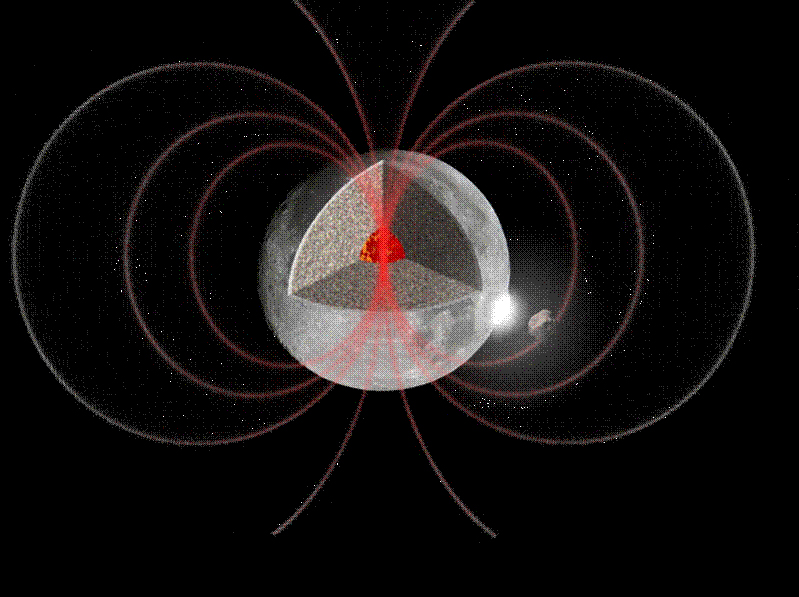Mystery of Moon's Lost Magnetism Solved?

One of the abiding mysteries of our moon is why it apparently once had a magnetic field. Now two teams of scientists have offered two separate, but potentially complementary, explanations.
When Apollo astronauts brought back samples of moon rocks from their lunar landing missions in the 1960s and '70s, some of them shocked scientists by being magnetic. That means that individual rocks might have a magnetic north and south pole and a small magnetic field of their own.
This can happen to rocks with the right minerals inside them, if they cool in the presence of a magnetic field. The problem is, scientists had no idea that the moon had ever had a magnetic field, and were at a loss to explain how that might have happened.
A magnetic field is generated by what's called a dynamo, which is caused by the fluid motion of a conducting material, such as liquid iron. In the case of the Earth's magnetic field, this motion occurs in the planet's outer core, and is caused by the convection of heat.
But the moon isn't large enough for convection to take place. Scientists were at a loss to explain what else might generate the required liquid motion of iron inside the moon, until now. [Photos: Our Changing Moon]
Stirring it up
In one new proposal, Christina Dwyer of the University of California, Santa Cruz, and her colleagues suggest that the moon's solid-rock middle layer, called its mantle, stirs up its liquid iron core. The researchers think this happens because the moon's core and its mantle rotate around slightly different axes, and the boundary between them is not quite spherical, so their relative motion causes the fluid to mix around.
Sign up for the Live Science daily newsletter now
Get the world’s most fascinating discoveries delivered straight to your inbox.
The strength of this stirring is determined by the angle between the core and the mantle, and the distance between the Earth and the moon, because the tidal gravitational tug from the Earth causes the moon's mantle to rotate differently than the core.
This model would explain why the moon used to have a magnetic field, but no longer does. That's because the angle between the mantle and the core has narrowed over time, while the distance between the moon and the Earth has widened, causing the tidal forces to steadily decrease. While these forces used to be enough to generate a dynamo inside the moon, they aren't anymore.
Based on their calculations, the researchers estimate the lunar magnetic field might have lasted for about a billion years, somewhere between around 2.7 billion and 4.2 billion years ago.
"Based on what we know about stirring, and everything we know about fluid motion, we can find no reason that this would not work," Dwyer told SPACE.com. "All the flags are go, and now this needs to be taken to the next level to get tested."
Dwyer said her research team had studied the basic scenario, but hopes that scientists who specialize in modeling the complex physics of dynamos will now step in to investigate whether this could explain what happened on the moon.
The researchers reported their theory in the Nov. 10 issue of the journal Nature.
Violent impacts
But theirs isn't the only possible solution to the moon's mystery.
In the same issue of Nature, Michael Le Bars of the French National Center for Scientific Research and the Université Aix-Marseille in France, along with his colleagues, propose another explanation for the ancient lunar magnetic field.
Le Bars' team also suggests that the moon's mantle might have stirred up the liquid in its core. However, they offer a different impetus for this stirring. Instead of tidal interactions between the Earth and the moon, the researchers posit that impacts by large space rocks slamming into the moon have changed its rotation rate, causing differential motion between the mantle and the core.
While the first scenario would cause steady stirring while the Earth and moon were the right distance apart, the second picture would induce brief periods of especially strong stirring of the core, creating spikes of a magnetic field on the moon.
While either option may be correct, it's also possible that both mechanisms played a role in causing an ancient magnetic field on the moon.
"The two studies are thought-provoking and may be complementary," Dominique Jault, a researcher at ETH Zürich in Switzerland and the Université Joseph-Fourier in France, who was not involved in either new study, wrote in an accompanying essay in the same issue of Nature. "Future palaeomagnetic experiments on samples from very old lunar rocks will enable their theories to be tested."
Editor's Note: This story has been corrected to reflect the fact that the distance between the Earth and the moon has been getting larger, not smaller, over time.
This story was provided by SPACE.com, a sister site to LiveScience. You can follow SPACE.com assistant managing editor Clara Moskowitz on Twitter @ClaraMoskowitz. Follow SPACE.com for the latest in space science and exploration news on Twitter @Spacedotcom and on Facebook.











